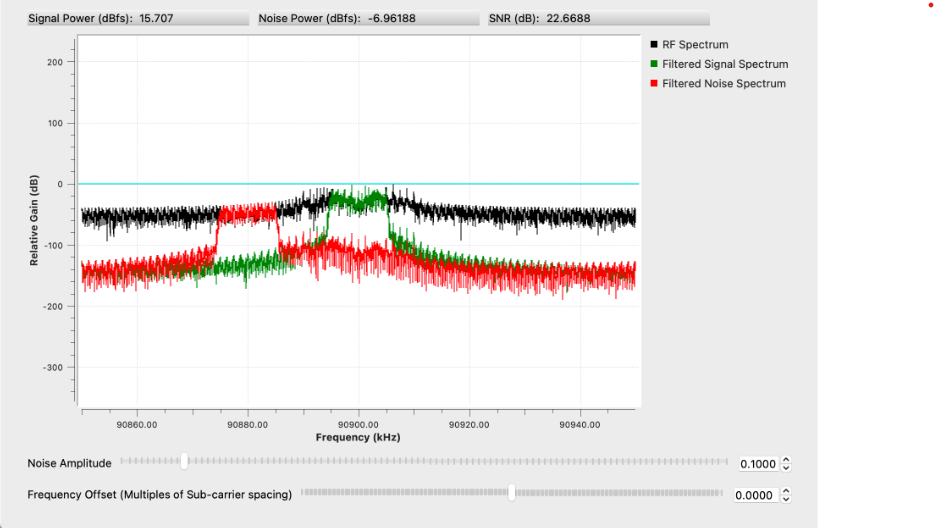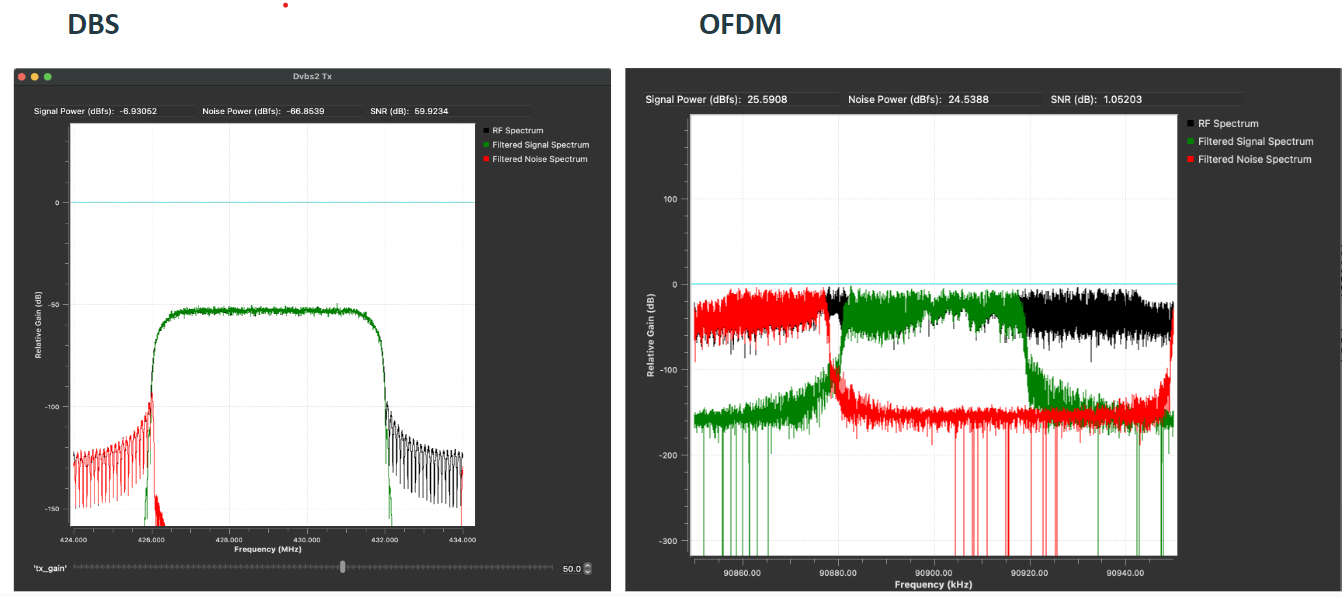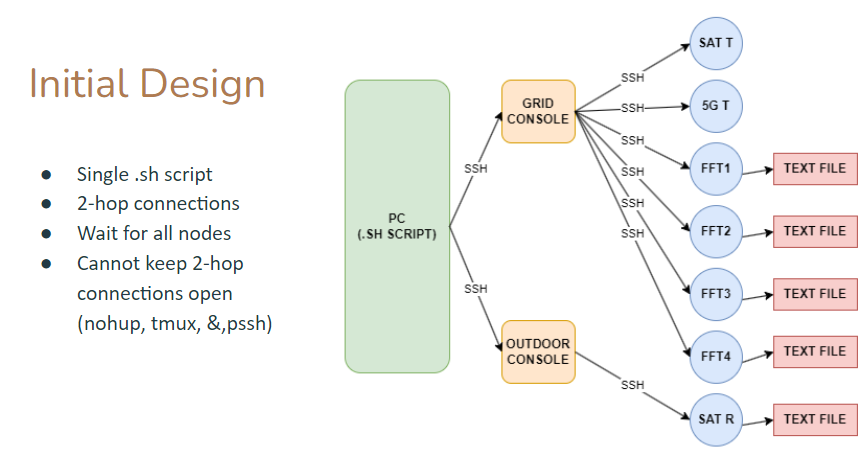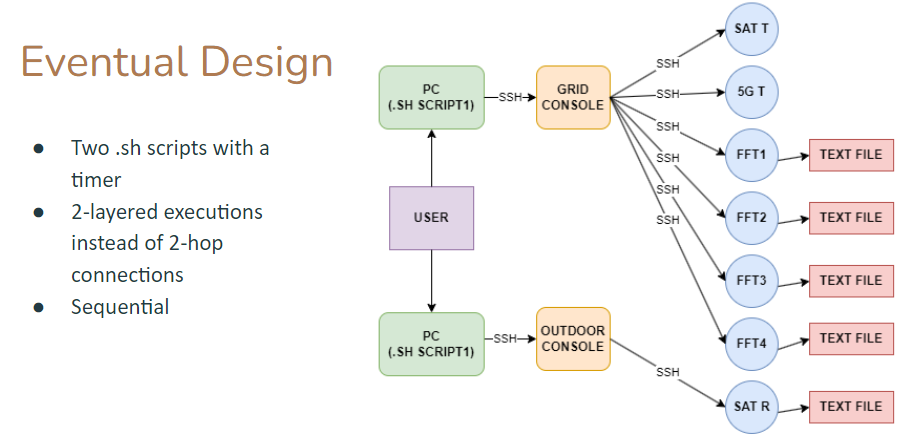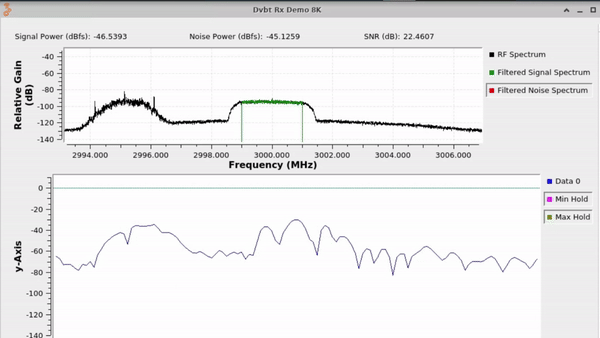| Version 35 (modified by , 16 months ago) ( diff ) |
|---|
Week 1 (5/28 - 5/30)
We installed and familiarized ourselves with GNU Radio.
We also explored the architecture of the Orbit test bed.
Reviewed several papers to gain insights into the current state of 5G networks and the interference mitigation techniques used across different frequency ranges.
Familiarized ourselves with the task of our research:
We will be emulating 5G Base Stations and other terrestrial network receivers on the FR3 spectrum. Using SDRs (software-defined radios) on the COSMOS testbed. We can simulate certain scenarios regarding interference directly through a software interface and generate Signal to Interference and Noise Ratio (SINR) data to train machine-learning models to help mitigate interference.
Week 2 (6/03 - 6/06)
We delved into the context of HyPhyLearn and conducted an in-depth exploration of Domain Adversarial Neural Networks (DANN).
Ran reference code for DANN and examined the source, target, and domain accuracies.
Analyzed graphs that demonstrated the model's ability to learn from domain-invariant features.
Reviewed Fourier analysis.
Researched and analyzed Orthogonal Frequency Division Multiplexing (OFDM) signals to understand what we will be using to simulate 5G base stations.
Designed a draft of an OFDM signal transmitter and receiver on GNU radio.
Week 3 (6/03 - 6/06)
We explored the TensorFlow implementation of the HyPhyLearn model, which classifies 2D Gaussian datasets.
Augmented the code from TensorFlow 1.0 to PyTorch and validated the experimentation.
Additionally, we explored how Dynamic Exclusion Zones apply to our mitigation objective. We weighed various approaches, debating whether the satellite receiver should autonomously localize interference sources or instead initiate a centralized algorithm for optimizing resource allocation.
Explored the amarisoft stack and instantiated UEs to send arbitrary data packets. Successfully received those data packets.
Examined a QPSK transmitter and receiver implementation. Analyzed all of the blocks used, to better understand the GnuRadio software.
Began researching possible ways to detect signals and perform energy spectrum sensing.
Week 4 (6/17 - 6/20)
Designed an SNR implementation for a generic FM transmitter.
Finished designing the OFDM transmitter.
Began fine-tuning the SNR implementation for OFDM transmissions.
Emulated a DVB Satellite Transmitter in GNU Radio for the ORBIT Sandbox 1 - ran into some issues with existing implementations.
Formulated specific plans for our data collection experiments:
Experiment 1 (SAT Reception)
- SAT Transmitter
- SAT Receiver
- 4 sensors that compute the FFT of the received signal
Experiment 2 (5G Interference)
- 5G Terrestrial Transmitter
- SAT Receiver
- 4 sensors that compute the FFT of the received signal
Experiment 3 (Network Coexistence)
- SAT Transmitter
- SAT Receiver
- 5G Terrestrial Transmitter
- 4 sensors that compute the FFT of the received signal
Designed the neural network's input/output formatting.
Week 5 (6/24 - 6/27)
Fine-tuned SNR to work with OFDM transmission
Troubleshooted issues with the signal transmission through signal analysis with Phosphor.
Began fine-tuning the SNR model to be working with the DBS transmission. Developed and validated our SNR Sensor. The sensor effectively differentiates the original signal from noise, allowing for accurate SNR value calculations. To ensure the sensor's accuracy, we also used FOSPHOR to verify its performance, which alleviated our initial skepticism about the readings. Now we have to test it for our 3 experiments.
We successfully implemented a Satellite Transmitter (DVBT) and a Satellite Receiver in GNU Radio for the ORBIT Sandbox 2. For the receiver, we developed and integrated a new block that converts stream FFT data into vectors, storing them as text files within the node. These files will serve as collected data to train our machine learning model to predict SINR values, which are our target labels.
During our first experiment, we encountered an issue where the connected UHD devices did not correspond to the physical location of the nodes. To address this, we are planning to connect to nodes using SDRs at different grid locations.
Also worked on automating the entire process to eliminate the need for the GNU Radio GUI. The following steps were taken:
- Extracted Python files and parameterized them, varying the transmitter gain.
- Created functions to log into different nodes.
- Streamlined the emulation process, including running time and data storage.
- Accelerated the process (one experiment every three seconds).
Week 6 (7/1 - 7/3)
Tested the automation process on the ORBIT Sandbox 2. Collected about 1000 measurements and then created a simple neural network that computes the transmitter's gain based on the receiver's FFT measurements, in order to test the data saving and data loading mechanisms.
Worked on scaling the SB2 Satellite Experiment up to the full Network Coexistence experiment on the ORBIT Grid. Matched the transmitter/receiver components to specific nodes. Debugged so that the nodes communicate with the on-site SDR devices.
Fine-tuned SNR to work with DBS transmission
Researched energy detection for SINR and possible GnuRadio implementations
Explored pilot-based OFDM SNR implementations
Week 7 (7/8 - 7/11)
Finalized a plan for SINR calculations in the scope of the experiment:
Step 1: Use 1st SNR implementation with satellite transmitter and receiver to measure signal and noise powers.
Step 2: Use 2nd SNR implementation with the OFDM transmitter and receiver to measure the second signal power (equivalent to interference values).
Step 3: Use the three values to calculate the SINR values that would occur if both OFDM transmitter and satellite were used simultaneously.
Tested SNR implementations with Sattelite and OFDM transmission on ORBIT nodes as well as the Outdoor Node with a 3G center frequency. Received accurate power values, so the SINR implementation to gather data has been completed.
Continued working on the structure of automating experimental data collection:
Week 8 (7/15 - 7/18)
Developed and Tested a Bit Error Rate (BER) gnuradio model on the satellite receiver.
Created a script that automates the collection of the data from the experiments.
Explored OFDM overlap in the band, and developed a methodology to utilize the collected data.
Week 9 (7/22 - 7/25)
Week 10 (7/29 - 8/1)
Attachments (26)
-
Screenshot 2024-07-11 104533.png
(89.9 KB
) - added by 16 months ago.
Initial Design
-
Screenshot 2024-07-11 104635.png
(90.2 KB
) - added by 16 months ago.
Eventual Design
-
ezgif-4-58b5ea63f1.gif
(678.0 KB
) - added by 16 months ago.
roaming OFDM
-
SNR.png
(1.3 MB
) - added by 16 months ago.
SNR Model
-
SNR.2.png
(1.3 MB
) - added by 16 months ago.
SNR Model
- Screenshot 2024-07-11 104533.2.png (22.5 KB ) - added by 16 months ago.
- Screenshot 2024-07-11 104635.2.png (22.3 KB ) - added by 16 months ago.
- DBS_OFDM.png (124.9 KB ) - added by 16 months ago.
- SNRGRAPH.png (98.3 KB ) - added by 16 months ago.
- 111.png (26.0 KB ) - added by 16 months ago.
- 222.png (28.4 KB ) - added by 16 months ago.
- 333.png (28.2 KB ) - added by 16 months ago.
- 444.png (28.5 KB ) - added by 16 months ago.
- sim.png (29.2 KB ) - added by 16 months ago.
- area.png (99.7 KB ) - added by 16 months ago.
- recap.png (436.6 KB ) - added by 16 months ago.
- week9.png (48.4 KB ) - added by 16 months ago.
-
Screenshot 2024-08-01 142828.png
(25.8 KB
) - added by 15 months ago.
Evaluation Metric
-
Screenshot 2024-08-01 142731.png
(39.8 KB
) - added by 15 months ago.
improved accuracy
-
Screenshot 2024-08-01 142526.png
(72.3 KB
) - added by 15 months ago.
Unimproved accuracy
-
ezgif-4-d566374993.gif
(393.1 KB
) - added by 15 months ago.
bullet
-
ezgif-7-41ef6e0043.gif
(204.3 KB
) - added by 15 months ago.
interpolation
-
arch1.png
(40.8 KB
) - added by 15 months ago.
arch1
-
arch2.png
(54.5 KB
) - added by 15 months ago.
arch2
-
arch3.png
(28.4 KB
) - added by 15 months ago.
arch3
-
M06 - 5G and Satellite Network Coexistence in the FR3 Spectrum.pptx
(26.4 MB
) - added by 15 months ago.
Final Presentation




